We often hear system designers complain that they can’t reduce their shading below ~1 to 2% on their ground-mount solar array, regardless of how widely they space the rows. This shade loss shows up in arrays with steeply tilted modules (30° or greater). The designer tries increasing the row spacing, and beyond a point it has practically no effect on the shade losses. In essence, this is “zombie” shading that is practically impossible to kill.
This phenomenon was a mystery—and the reason why it was occurring surprised even us, forcing us to reconsider what shade losses even are.
An incorrect hypothesis
This “zombie” shading shows up for our users all the time. It seems to come up most often on projects in northern states, such as Minnesota or Massachusetts. And it isn’t just a user error—this is something that anyone can replicate with a steeply tilted array.
Given the geographic footprint, we thought we knew what the cause was: latitude. At high latitudes, much of the sun’s energy comes in from lower angles in the sky. With lower sun angles, you have longer shadows, and therefore greater row-to-row shading, even with wide row spacing. In fact, we already looked into this in our earlier analysis on wall-mounted solar, and showed that the weighted average elevation angle of sunlight is 32° in Alaska vs. 47° in Florida.
Back to the high-tilted designs: the plot thickens when we look at this same design in Charlotte. With an array much further to the south, the shade losses at very wide row spacing are practically the same! This pretty much proves that this loss isn’t from the sun angles at northern latitudes.
The surprising answer
We then decided to dig deeper into the numbers behind the shade loss—specifically, the components of sunlight. There are two main parts of sunlight that we talk about all the time: the direct sunlight (the beams from the sun) and diffuse sunlight (the brightness of the blue sky). Typically, direct sunlight accounts for 60 to 70% of total sunlight, with diffuse accounting for 30 to 40%. But there is also a third one that rarely matters: Albedo (the reflection from the ground). Albedo never matters for standard arrays, for two reasons. First, the ground makes up a tiny proportion of the modules’ plane-of-array view, since modules that are tilted up are mostly “looking at” the sky, with the ground a tiny slice of the view. Second, the reflection from the ground only strikes the first row of the array, and the first row then blocks the ground reflection from the second row of modules. As a result, the overall albedo number is always really small, typically 0.1% to 0.3% of total sunlight.
Yet once we looked into the details, it turns out that the “albedo is tiny” mindset changes once your tilt is up to 30° tilt. When you tilt the array up at 30°, the plane-of-array albedo contribution to sunlight actually goes up to over 2%. Not huge, but now it is something you will notice. As the plane-of-array albedo value grows, you still have the phenomenon that the first row of modules blocks the view of the second/third/etc. As a result, the increased plane-of-array albedo sunlight is immediately lost and counted as shade loss.
It is this “ground shading” that ends up accounting for the majority of the “zombie” shade losses in these high-tilt arrays. Depending on the tilt angle, the lost albedo accounts for between 60-90% of the shade losses in these designs. For example, in the example below, note that 1.8% of the 2.9% shade loss is from albedo shading (and most of the rest comes from diffuse, not direct).
So the reason this phenomenon was coming up in northern locations wasn’t due to the sun angles, it just happens that designers were designing high-tilt systems in northern latitudes, and the tilt made the albedo a more significant share of sunlight.
A philosophical question: What is shade loss, really?
This ultimately brings up a broader question: When is shading loss actually shading loss? We typically think of shade as something blocking sunlight from striking the surface of a module. But in this case, blocking the reflection from the ground feels different. After all, most arrays don’t even get much albedo/reflection sunlight to begin with. High-tilt arrays have a much bigger plane-of-array albedo because of their tilt, but then immediately lose it from row-to-row shade. It’s arguably just an accounting technicality.
If a tree falls in the woods, and there’s nobody there to hear it, does it make a sound? If my high-tilt array gets more ground reflection, but then immediately blocks it from itself, is it really shade loss?





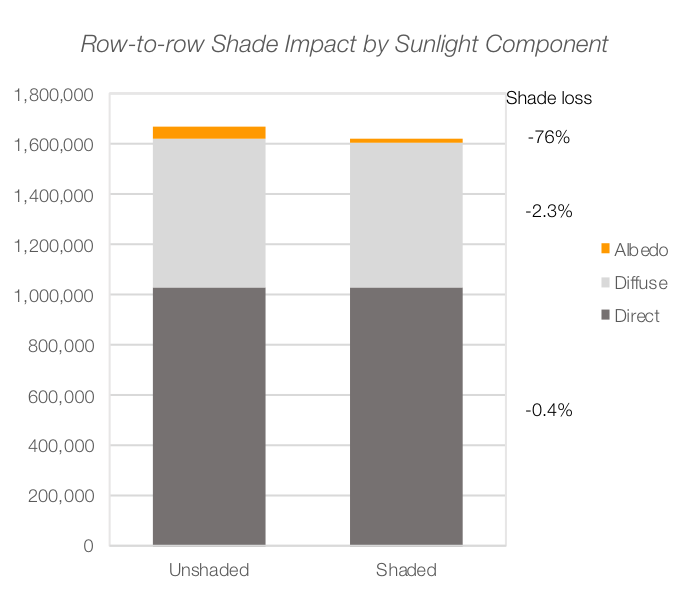
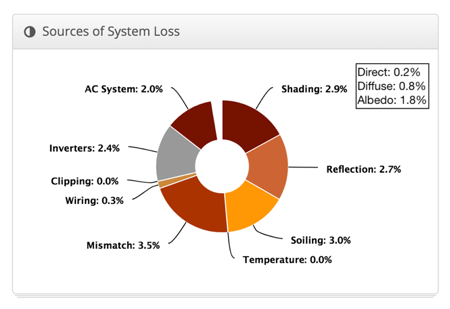
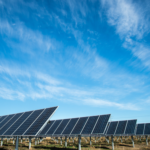

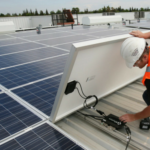
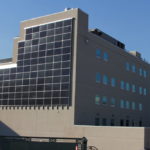



Although we hear about ‘special’ coatings that are supposed to make the solar PV panels more efficient in capturing the light, there are still the physics of light to consider. There is a possibility that on fixed arrays in particular, the “angle of incidence” of the sun to the panel with its tilt creates the critical angle of 42 degrees. This is where a piece of glass can act like a mirror and reflect a portion of the light away from the panels. How long does this critical angle last? It would depend on the original angle of a fixed panel array and month of the year. Why don’t we see this happening? The use of MPPT for the inverter(s) allows the most power capture for the real time conditions during the day. You’re talking 2% here, over the course of a day, the MPPT keeps the power output of the inverter pretty well regulated to get the most from your solar array.
Does the albedo effect have any impact on my single plane 2 axis solar array when it is 80 degrees to the horizontal at early morning and late afternoon?
Or put differently, Is my Kw output increased significantly at these times?
Hi Neil, your intuition is right on! Trackers, especially dual-axis trackers, will get more of their sunlight from ground reflection. We don’t have dual-axis trackers in HelioScope, but running a couple simulations in NREL/SAM shows that ground reflection gains for dual-axis trackers are in the 1-2% range (higher in Vermont than Phoenix).
Note that SAM groups ground reflection in with diffuse irradiance, so the only way to see that effect is to run a couple simulations. (HelioScope breaks out reflected irradiance separately, but doesn’t let you edit the albedo values.)
Will dual axis trackers be added to helioscope? Does it have fixed tilt azimuth trackers?
Or… might steeper tilt arrays make a comeback (due to high production in winter months) IF bi-facial modules are used? Might double-axis trackers finally break through the real-estate cost barrier? Or will declining cost of energy moot all this discussion?
Ultimately, draw a circle around the top of a solar array, and the same amount of sunlight will fall through it regardless of the tilt angle underneath. The best fixed tilt angle (assuming CHEAP modules) is dense, bi-facial, and flat. Otherwise, tracking to some degree should be considered… but do we need morning and evening production? Or will batteries moot that time-of-day difference and summer vs. winter production regain prominence?
At the end of it all: dense, bi-facial, and flat.
Until it is so cheap that it is dense, bi-facial, and vertical.
But in that case… which orientation?
Hopefully we will have discovered cold fusion by then. In the meantime, thank goodness we have solar design software like Helioscope to help us with the analysis!
Hey John! Bi-facial modules are interesting. The biggest question there is empirical: we need good, real-world data in order to understand the back-side reflection gains. (It isn’t the kind of problem where a bunch of smart people can just lock themselves into a room and “figure it out”.) So we’re generally waiting on the market (especially the IE’s) to coalesce around the math for how we should model bi-facial gains.
That being said, you raise an interesting point: what is the tilt of that dataset that folks are collecting? Hopefully the researchers are testing a range of tilt angles, so we can properly simulate high-tilt versus low-tilt bi-facial arrays!